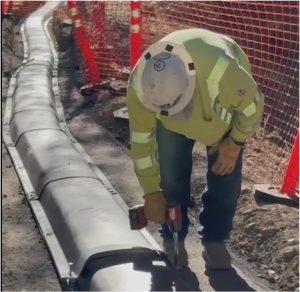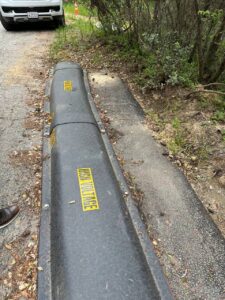Electric Power Distribution In California
With our patented Electric Power Distribution System (GLDS) in California, power lines are neither suspended from utility poles nor buried underground. Instead, lines are placed inside protected and resilient conduits that rest on the ground. This places the electric cable in a conduit in a specially molded tray, tied in with a Basalt Rebar, sealed with a special Geopolymer cement, placed at ground level and capped in engineered.
GLDS enables faster construction and reduced cost. The system is ideal for locations where under-grounding is not feasible due to hard granite, lava rock or cultural and environmental conditions.
The new method which inserts the cable into a hard surface that typically can’t be cut open with everyday tools (and withstands being run over by semi-trucks without damage) and can be done 2-3 times faster. The boxes can be put a few inches into the ground, but without the typical fuss of digging trenches.
Benefits of GLDS:
As the demand for reliable and efficient utility services continues to grow, utility companies are constantly exploring innovative solutions to enhance their infrastructure. One such solution gaining traction is the Ground Level Distribution System (GLDS). Unlike traditional overhead or underground distribution methods, GLDS is designed to be laid above the ground, offering several advantages that can significantly benefit utility providers. Here’s a closer look at the benefits of using GLDS for utility companies.

1. Enhanced Accessibility
One of the most significant advantages of GLDS is the ease of access it provides for maintenance and repairs. Since the system is positioned at ground level, utility workers can quickly reach and address issues without the need for specialized equipment like cranes or bucket trucks typically required for overhead systems. This accessibility can lead to reduced downtime and quicker response times to service disruptions, ultimately improving customer satisfaction.
2. Cost-Effectiveness
Implementing a GLDS can be more cost-effective than both overhead and underground distribution systems. While the initial installation costs may be comparable to traditional methods, the ongoing maintenance expenses can be significantly lower. Utility companies can save on labor and equipment costs due to the ease of access for repairs and maintenance. Additionally, GLDS can reduce the need for expensive excavation and restoration associated with underground installations.
3. Reduced Aesthetic Impact
GLDS offers a solution that minimizes the visual clutter often associated with overhead distribution systems. By using low-profile structures and equipment, utility companies can enhance the aesthetic appeal of urban and suburban environments. This is particularly beneficial in areas where preserving the landscape and maintaining property values are priorities for local communities.
4. Improved Safety
Safety is a paramount concern for utility companies, and GLDS contributes to a safer working environment. With the distribution system at ground level, the risk of accidents associated with overhead lines, such as falling debris or electrical hazards from storm damage, is significantly reduced. Furthermore, utility workers can perform their tasks more safely and efficiently, decreasing the likelihood of workplace injuries.
5. Flexibility and Scalability
GLDS systems offer utility companies the flexibility to adapt to changing demands. As population growth and urban development continue, utility providers can easily expand their GLDS networks to accommodate new customers and service areas. This scalability allows for quicker implementation of necessary upgrades or expansions without extensive infrastructure overhauls.

6. Reliability in Adverse Weather
Ground Level Distribution Systems are generally less vulnerable to severe weather conditions compared to overhead systems. High winds, ice storms, and heavy snowfall can cause significant damage to traditional overhead lines, leading to outages and service disruptions. GLDS minimizes this risk, resulting in more reliable service delivery, especially in areas prone to extreme weather.
7. Integration with Smart Technology
The modern utility landscape increasingly relies on smart technologies to improve efficiency and customer engagement. GLDS can be easily integrated with advanced monitoring and control systems, allowing utility companies to implement smart grid technologies. This integration enables real-time monitoring of system performance, improved load management, and enhanced operational efficiency.
8. Environmental Considerations
While not an underground solution, GLDS can still offer environmental benefits by reducing the need for extensive tree trimming and vegetation management associated with overhead lines. This can help preserve local ecosystems and minimize the impact on wildlife habitats. Additionally, the lower carbon footprint associated with maintenance activities contributes to more sustainable utility operations.
Conclusion
The Ground Level Distribution System (GLDS) represents a forward-thinking solution for utility companies looking to enhance their infrastructure while meeting the growing demands of customers. With benefits such as improved accessibility, cost-effectiveness, reduced aesthetic impact, and enhanced reliability, GLDS is an attractive option for utilities seeking to modernize their service delivery methods. As the utility industry continues to evolve, embracing innovative solutions like GLDS will be essential for providing reliable, efficient, and sustainable services to communities.
For all your Electric Power Distribution needs in California Contact Energy Connect Corp today.
